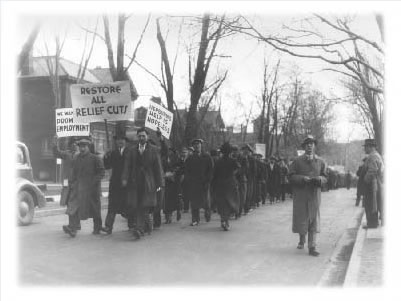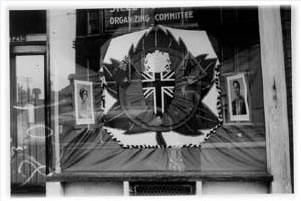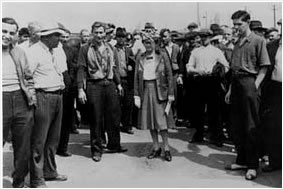USW HISTORY
 THE UNITED STEELWORKERS IN CANADA: A STORY OF STRUGGLE, GROWTH, AND EVOLUTION
THE UNITED STEELWORKERS IN CANADA: A STORY OF STRUGGLE, GROWTH, AND EVOLUTION
Women and men without the protection and bargaining strength of a union must depend on the ‘goodwill’ of management.
A union gives you better pay and benefits, fairness, job security, a voice and respect at work. USW works with you and your coworkers to end unfair or discriminatory treatment at work, to find processes that work instead of arbitrary rules, favouritism and intimidation. Working with USW, you can make work safer and improve the job satisfaction and self-esteem in your workplace.
USW will help anybody who needs a union, whether in traditional industries or in universities, nursing homes, financial services, call centres or transportation and more.
If you or your partner, son, daughter, friend or a neighbour is unhappy about how they are treated at work or too concerned about the consequences of standing up for their rights, calling the steelworkers is the best first step to take.
‘SWOC’ COMES TO CANADA
That all changed with the rise of industrial unionism – a movement to organize and unite all workers in mass-production

industries. It was a strategy that gained momentum with the US-based Congress of Industrial Organizations (CIO), which formed various organizing committees, among them the Steelworkers’ Organizing Committee (SWOC). It was a strategy without borders, and it gave rise to international unions like the United Steelworkers, the United Auto Workers and many more. With an initial budget of $500,000, the loan of 150 organizers recruited from CIO unions, and with headquarters in Pittsburgh, SWOC launched its campaign in June 1936.
In Canada, SWOC organizing began from the Labour Temple in Hamilton. Steelworkers in Nova Scotia organized most quickly under the leadership of Silby Barrett and the union signed contracts with the company that eventually became Sydney Steel. That achievement made Local 1064 the earliest Steelworker local in Canada.
In 1940, an independent steelworkers’ union at Algoma in Sault Ste. Marie, affiliated with SWOC and the union also began organizing small fabricating plants. In Hamilton, Local 1005 was organized at Stelco in 1936, but it took several years to gain management’s recognition of
the union. With the growth of the steel industry during the Second World War, steelworkers continued to organize and the union’s foundation was built.
By May 1942, SWOC had organized 700,000 workers in Canada and the U.S. It was time to take the next step. At a convention in Cleveland, delegates voted unanimously to adopt a constitution and change the name to the United Steelworkers of America.
BLENDED HISTORIES, COMMON FUTURE
Union mergers with the steelworkers have included the emotionally and politically charged merger in 1967 with the International Union of Mine, Mill and Smelter Workers. In Canada, the struggle to win the hearts and minds of Mine-Mill members was most strongly felt in Sudbury, Ontario, and Trail, British Columbia. Today, the United Steelworkers is a powerful part of both communities through Locals 6500 and 6600 in Sudbury, and Locals 480 and 9705 in Trail.
A WORD ABOUT STRUCTURE
Although the structure has evolved over the years, the steelworkers today maintain a four-member executive of top officers, and 12 geographical districts, each headed by a director. In Canada, there is a national director, Ken Neumann, and three district directors – Steve Hunt, District 3 (Western Canada and the territories); Wayne Fraser, District 6 (Ontario and Atlantic Canada); Michel Arsenault, District 5 (Quebec).
In 1985, the Upholsterers’ International Union merged and, more recently, mergers with the United Rubber Workers and the Aluminum, Brick and Glass Workers have once again brought together old CIO-organized unions together under one, modern union umbrella. That umbrella is the United Steelworkers.
At the close of the century, Canadian Steelworkers are also being joined by the Transportation Communications Union (TCU) and, in Quebec, by the Federation of Aluminum Sector Workers (FSSA).
DEMOCRACY AND AUTONOMY
The union’s international structure and its healthy international strike-and-defense fund have strengthened the development of the Steelworkers in Canada. At the same time, Canadians are autonomous in their policies and operation. With local autonomy as one of its cornerstones, diversity and strength are enhanced as locals chart their own course. They are supported by a corps of ‘staff representatives’ strategically located in offices across Canada, and a team of staff in the Union’s National Office with specialized skills in research, member education, job evaluation, training, communications, health and safety, and international affairs. The National Office also maintains an in-house legal service.
Democracy in the steelworkers’ union is an important and involved process. Rather than holding delegate-based elections during conventions or conferences, the United Steelworkers uses a referendum process every four years. Each member throughout the union is eligible to vote for his or her district and national directors, as well as for the four international officers.
CLASSIC CONFRONTATIONS
Among the struggles that have shaped the story of the union is a classic confrontation between the steelworkers and the company that today is Stelco. In 1946, the Steel Company of Canada in Hamilton sought to rid itself of a union, which the company believed was imposed upon it only because of wartime conditions. For 10 weeks that year, Steelworkers would do battle with the company, as well as hostile provincial and federal governments. The Stelco strike of ’46 is an integral part of United Steelworkers’ history, as well as the community of Hamilton. With the industry recognized as critical to the nation’s economic growth, a federal ‘steel controller’ had decreed heavy fines and prison terms for those who ignored his orders. The union responded by declaring that “if they arrest five on the strike committee, five more will take their place until all union members are in jail.”
The company brought more than 1,000 strike breakers (scabs) into the plant, where they were fed and housed. But outside, the “Whisper”, a motor launch used by the union seriously stopped the flow of supplies from Hamilton Bay on Lake Ontario into the plant. A light plane was used to drop leaflets. The result of this solidarity and ingenuity eventually forced Stelco to bargain with the union, and resulted in a dedicated and informed membership.
In the photo above, anti-worker city councillor Nora Henderson visits Stelco picket line in 1946. Though now part of history, the 1946 strike still has some lessons to teach about sticking with the union and creating innovative ways to maintain and improve workers’ rights.
EARLY LEADERS
The strike also produced its share of leaders, both within the local and within the union as a whole. Leaders who emerged included Larry Sefton who would become Director of District 6 (then Ontario) for 20 years. Sefton also figured prominently in the Northern Ontario miners’ strike of the same era. Sefton died in 1973. His achievements remained and, in 1986, a space in the heart of downtown Toronto – just behind city hall – was dedicated to his memory. A lecture series in his name is also an annual feature of the University of Toronto’s Woodsworth College Centre for Industrial Relations.
Another Steelworker leader, whose roots are traced to the earliest days of the union is Lynn Williams, who was elected International President in 1984 after serving as District 6 Director, and later as the union’s International Secretary. In the late 1940s, Williams helped organize and was a member of Local 2900 at Inglis, the downtown Toronto factory that manufactured everything from giant glass tanks for the brewing industry to Bren guns in WWII and pots and pans and fishing rods.
The life of Local 2900 and the Inglis plant was chronicled in the book, Working at Inglis, by David Sobel and Susan Meurer. The plant, which in its final days supplied washing machines for the Canadian market of Whirlpool Inc., was one of the first victims of the Canada-U.S. Free Trade Agreement, closing forever in 1989 and demolished a few years later. Local 2900 stories are also retold in Working Days, a film by independent producer Darrell Varga. Local 2900 stories are also re-told in Working Days, a film by independent producer Darrell Varga. Even today, when word gets out about a Local 2900 reunion, a good turnout is guaranteed.
Lynn Williams never forgot his roots and, though retired since 1994, remains active in the union. He is the president emeritus of the Steelworkers’ Organization of Active Retirees (SOAR).
STRUGGLES THAT MADE WORK BETTER AND SAFER
Historic struggles that have led to improved working conditions for Steelworkers and other workers include the 1974 strike in Elliott Lake, where uranium miners took action, not for better wages, but for the necessary protection that the company would not provide. The result was a Royal Commission and changes to provincial legislation, which benefited every worker in Ontario. Without the leadership of the union, the risks faced on the job would be even greater.
Quebec’s labour history, too, has been shaped by the United Steelworkers, especially the lengthy campaign to represent miners at Noranda-owned Gaspé Copper in Murdochville. A seven-month strike in 1957 for union recognition was one of the pivotal Labour struggles in the province and set the stage for activism on several fronts in the 1960s ‘Quiet Revolution’. Murdochville was anything but quiet and it took another nine years after the ’57 strike for the union to be certified.
An earlier strike against Noranda in 1953 was part of a campaign that established the Steelworkers in the mining industry of Quebec and Northern Ontario. Though governments were unsympathetic, legislation discouraged some of the tactics mining companies had used in earlier decades. The union was also able to finance a prolonged series of strikes across the north, although it was a hard struggle.
FOR A PENNY AN HOUR – THE STEELWORKERS HUMANITY FUND
Part of the Steelworkers’ evolution has been a unique approach to international affairs. In fact, the Steelworkers Humanity Fund became a model for other unions in Canada. The Humanity Fund was established in 1985 as a voluntary, negotiated checkoff for members and locals, with the proceeds directed in the early years to international relief and development, as well as a portion allocated to relief efforts in Canada (food bank donations and natural disaster assistance like the Saguenay and Winnipeg floods, and the 1998 ice storm).
Today, the Humanity Fund generates over $1 million a year and has broadened its scope to include closer links with worker organizations in areas of the world where workers have little or no representation.
In addition, the United Steelworkers was the lead organization in a 1998 coalition to launch the first-ever complaint filed with the National Administration Office of the NAFTA side agreement on labour.
POLITICAL ACTION – A PARTISAN AFFAIR
The United Steelworkers has never wavered in its support for the New Democratic Party. Steelworkers have been elected as MPs, MPPs and MLAs, and Steelworker activists have been familiar faces in campaigns from coast to coast.
Political action for the Steelworkers is vigorously partisan. The union’s roots in this area come through the European experience of direct labour involvement with the parliamentary process. Charles Millard, the first elected Canadian director of the union back in the 1940s, was among those progressives who understood that to build a strong labour movement, it must work through a party which would seek and protect the goals needed for working people.
Leading the fight for better working and social conditions at the bargaining table, Steelworkers were active in the NDP’s predecessor, the Cooperative Commonwealth Federation (CCF). Leaders like Larry Sefton, Eamon Park, Lynn Williams and Charles Millard ran for the party. Millard and Park were elected to the Ontario Legislature in 1948 and served until 1951.
With the Steelworkers playing a prominent role, the Canadian Labour Congress invited the CCF and other progressive forces to form a new social democratic party in Canada, the NDP. Steelworkers believe strongly in the partnership that it has with the NDP.
In Quebec, Steelworkers have been active in support for the Parti Québecois, which was responsible for, among other reforms, the first anti-scab legislation in North America.



